Abstract
In one component of a multiple schedule, pigeons were required to complete the same four-response chain each session by responding sequentially on three identically lighted keys in the presence of four successively presented colors (chain performance). Food presentation occurred after five completions of the chain (i.e., after 20 correct responses). Errors, such as responding on the center or right key when the left was designated correct, produced a brief timeout but did not reset the chain. In the other component, responding on a single key (lighted white) was maintained by food presentation under a fixed-ratio 20 schedule. In general, phencyclidine and d-amphetamine produced dose-dependent decreases in the overall response rates in both components. With pentobarbital, overall rate in each component generally increased at intermediate doses and decreased at higher doses. All three drugs produced dose-dependent disruptive effects on chain-performance accuracy. Phencyclidine and pentobarbital increased percent errors at doses that had little or no rate-decreasing effects, whereas d-amphetamine generally increased percent errors only at doses that substantially decreased overall rate. At high doses, all three drugs produced greater disruption of chain performance than of fixed-ratio performance, as indicated by a slower return to control responding, although the effects of d-amphetamine were less selective than those of phencyclidine or pentobarbital.
Full text
PDF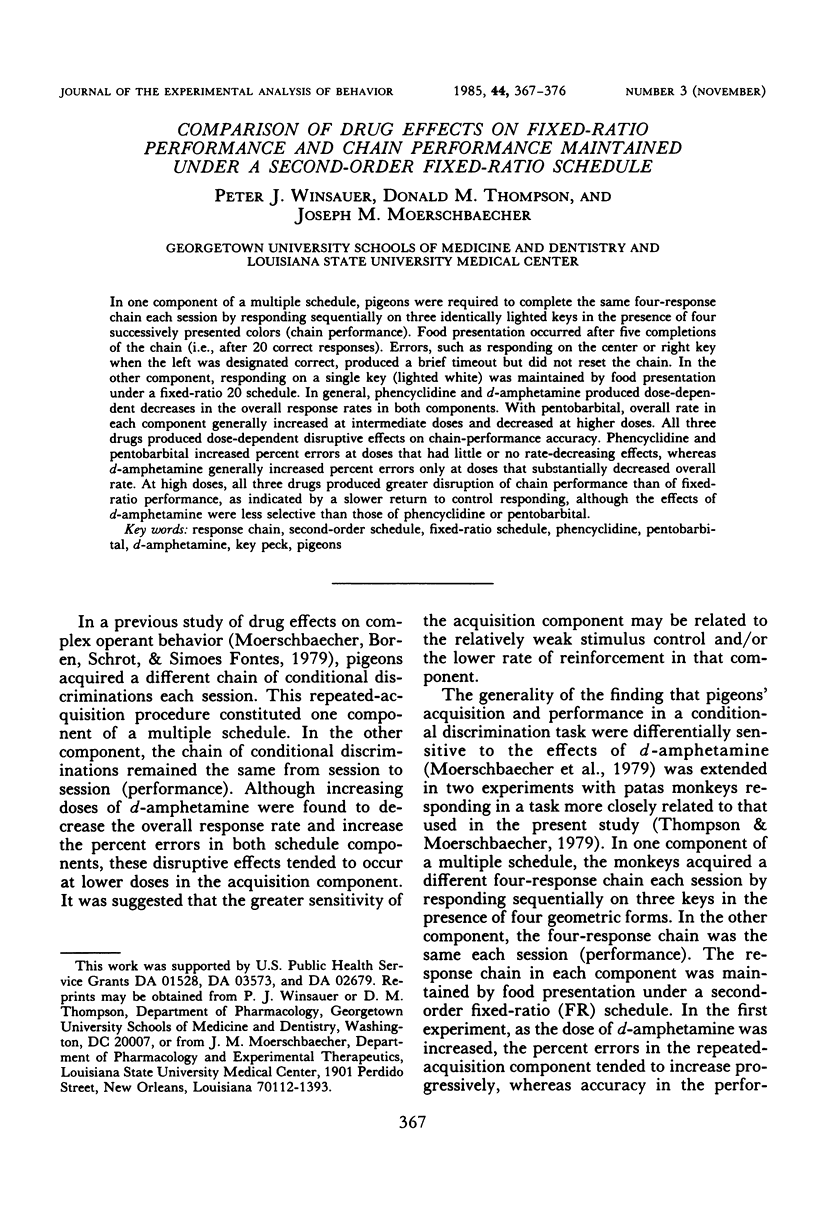
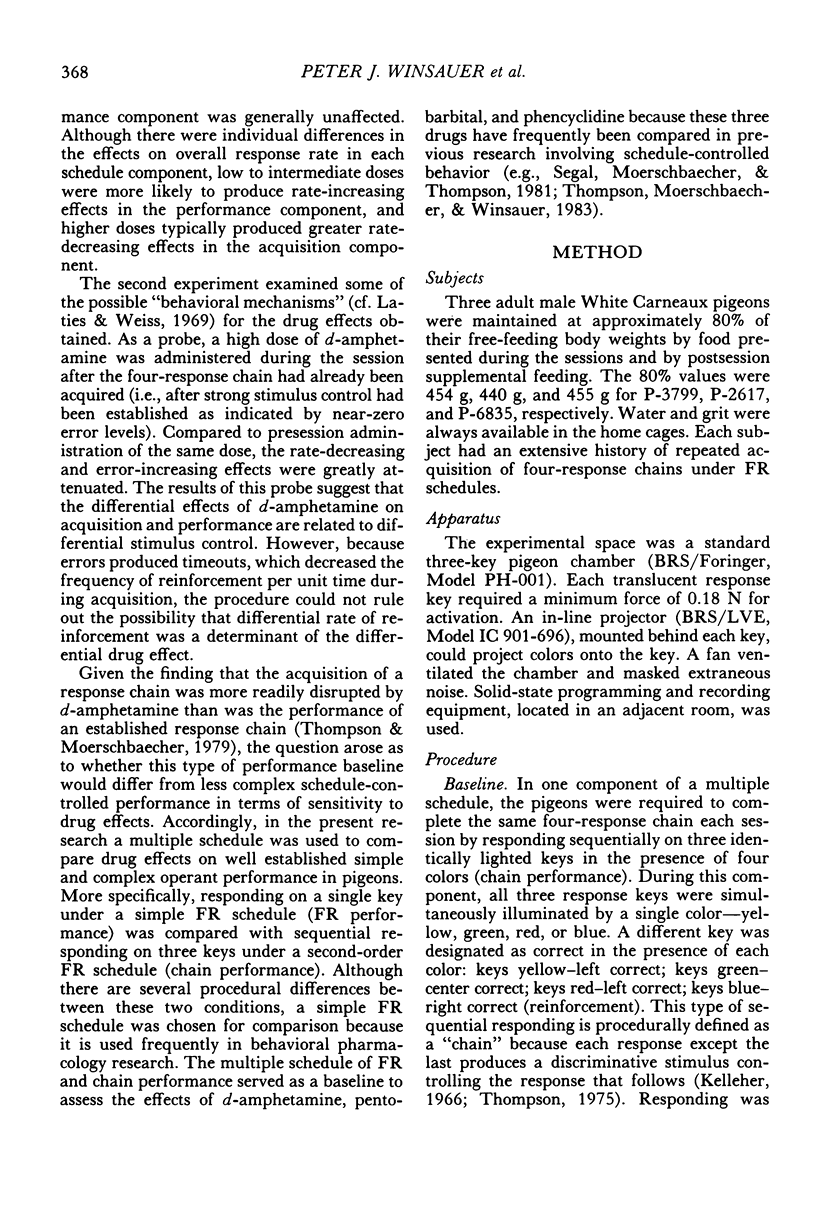
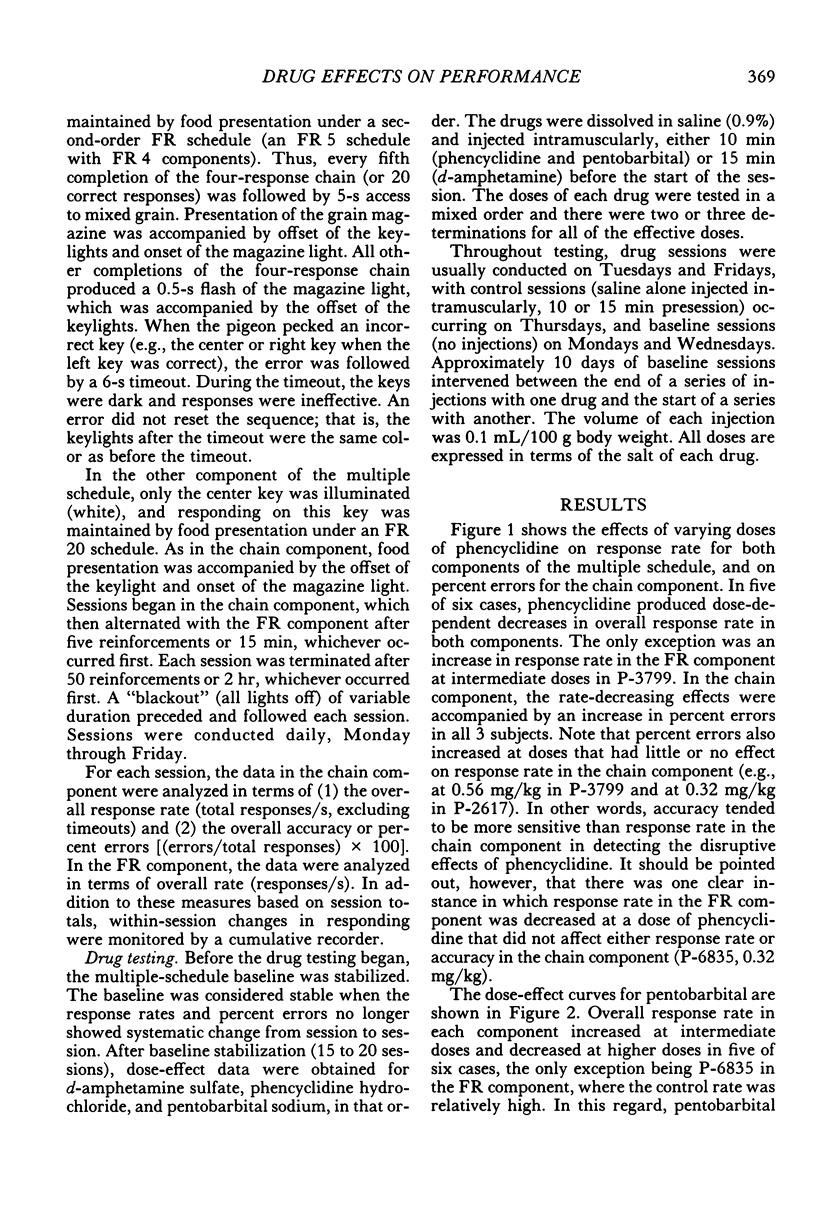
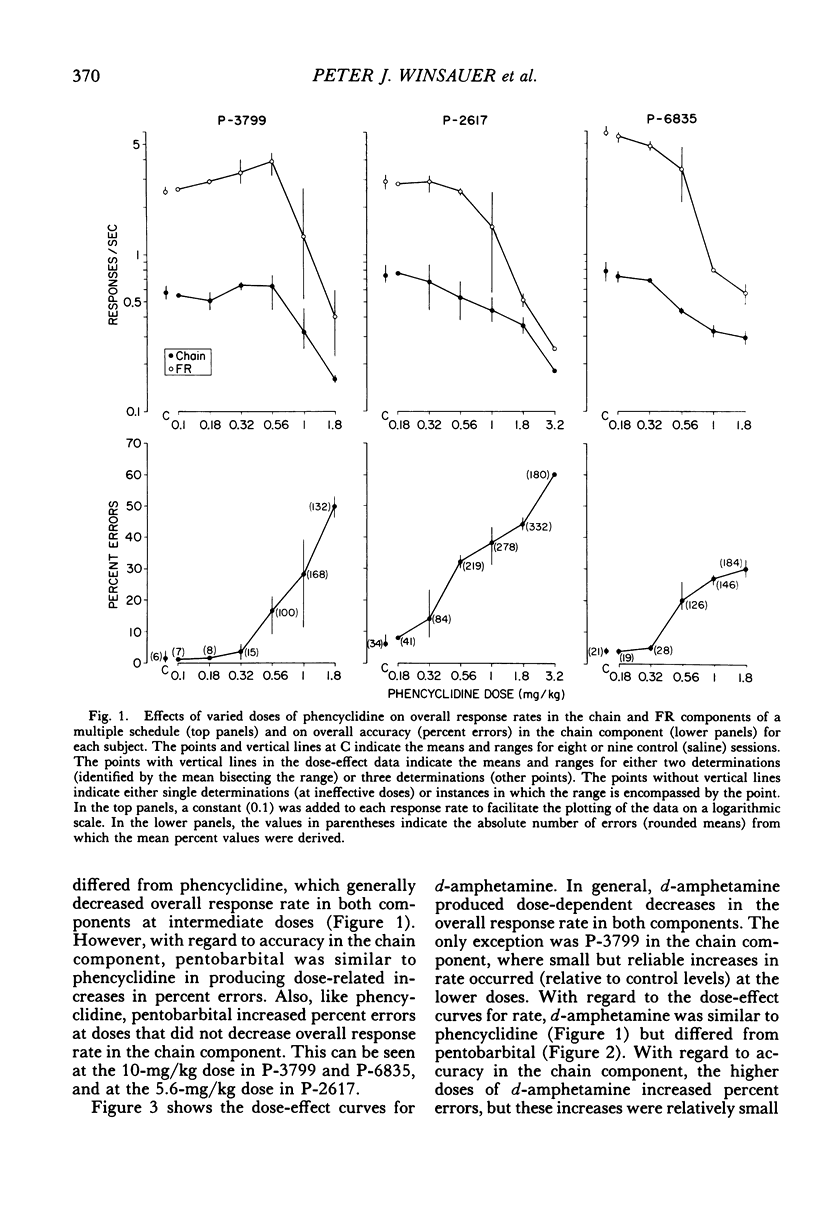
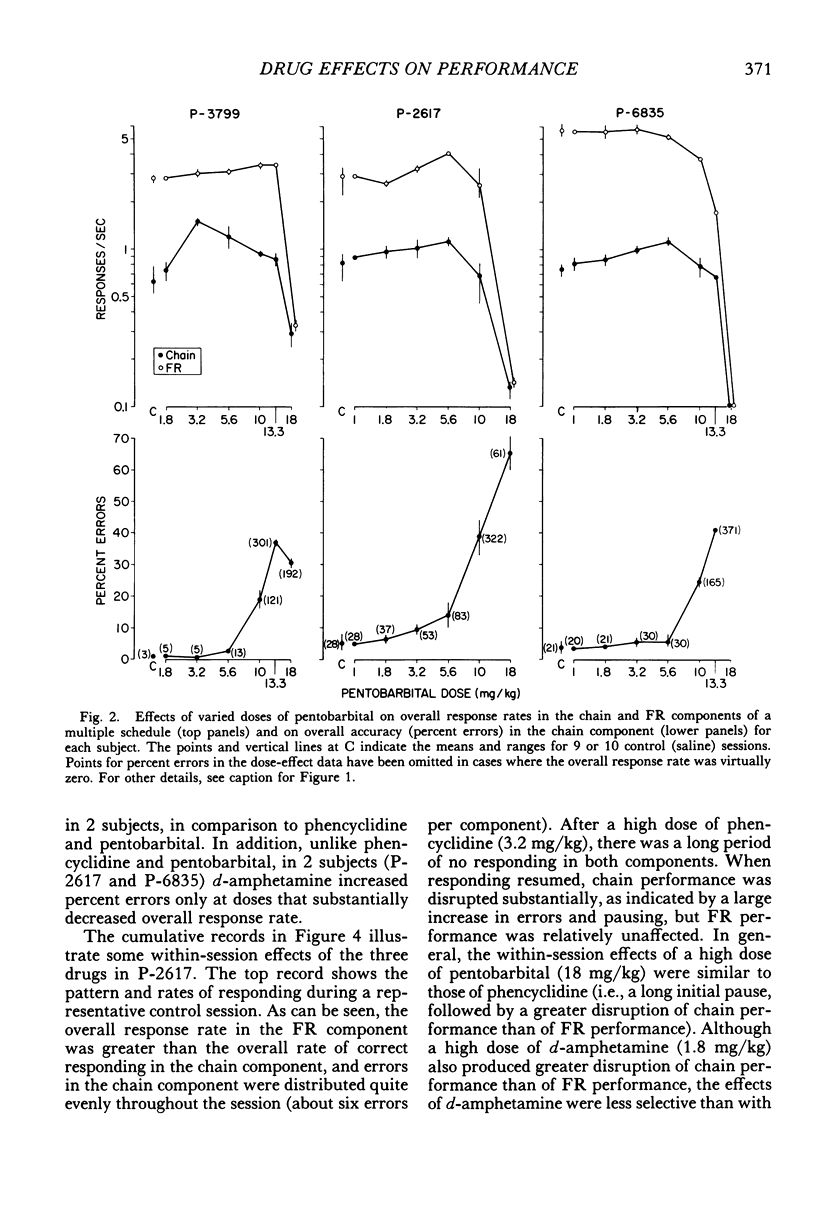
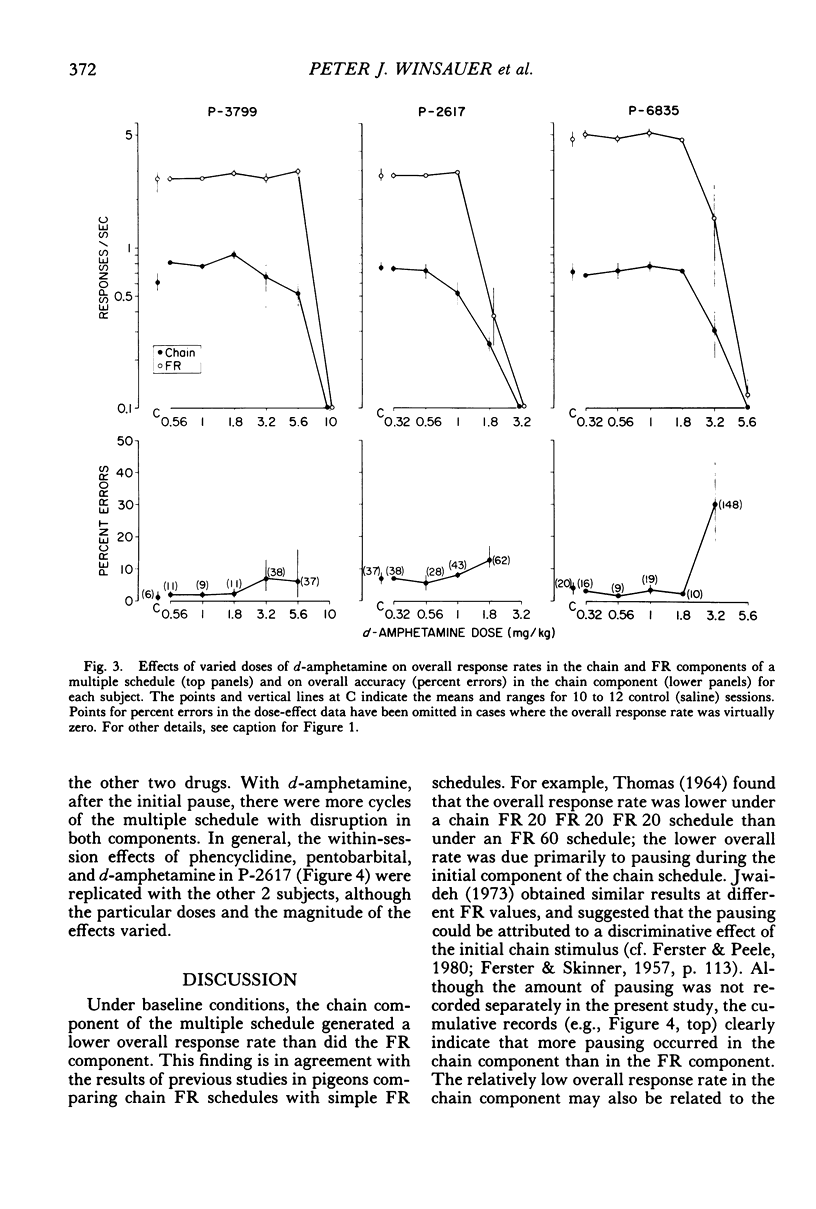
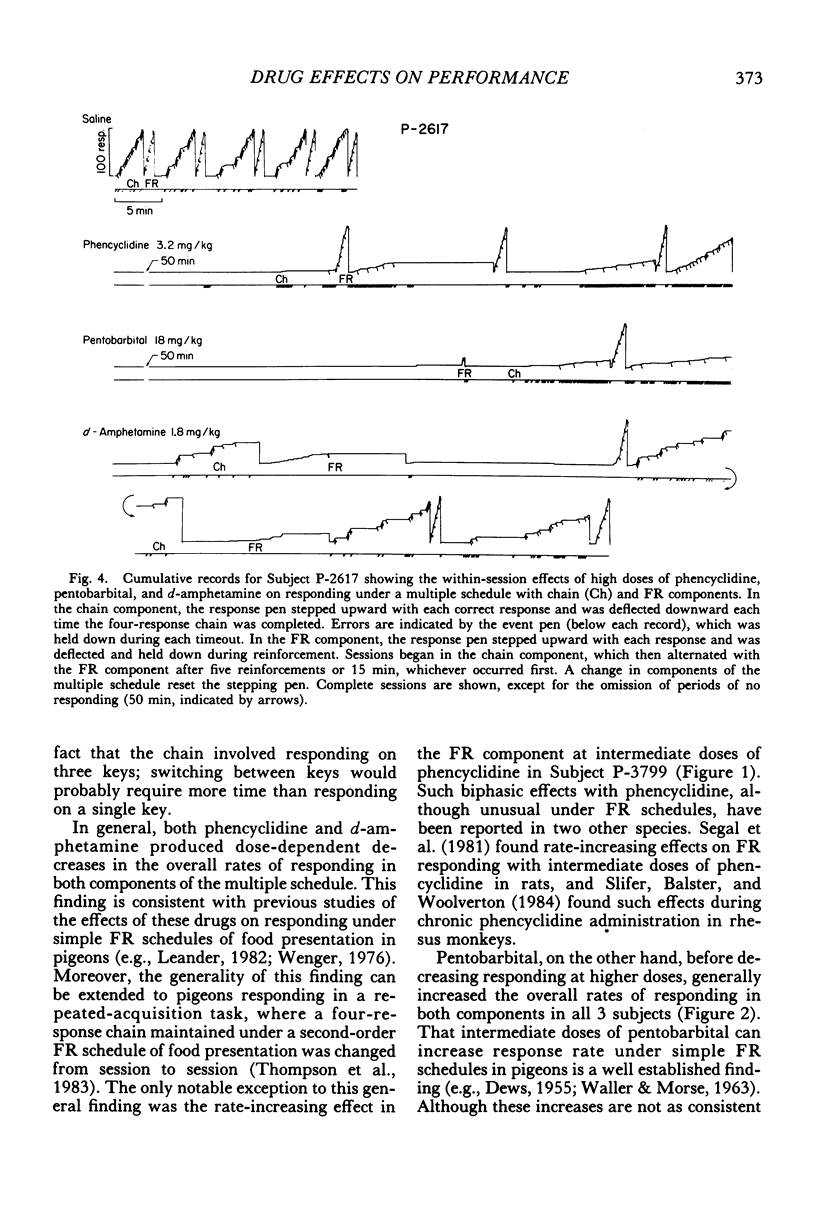
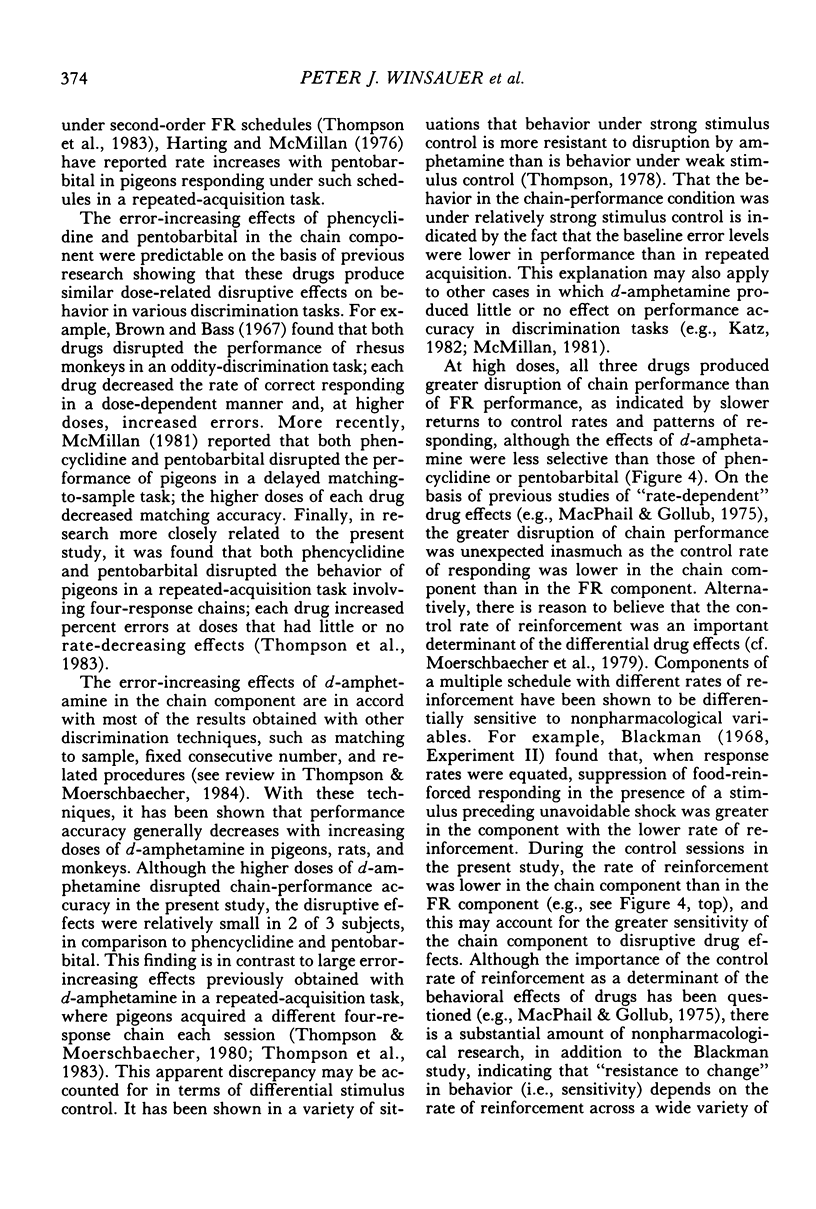
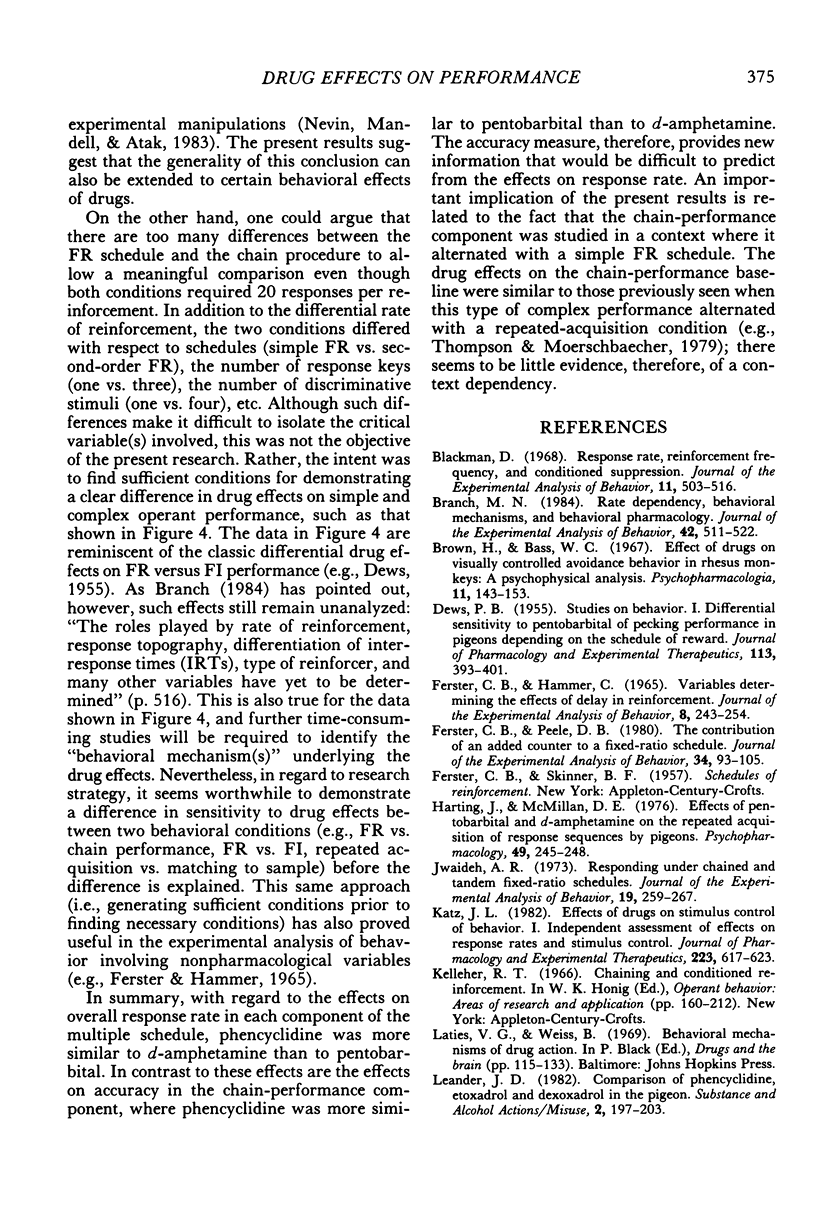
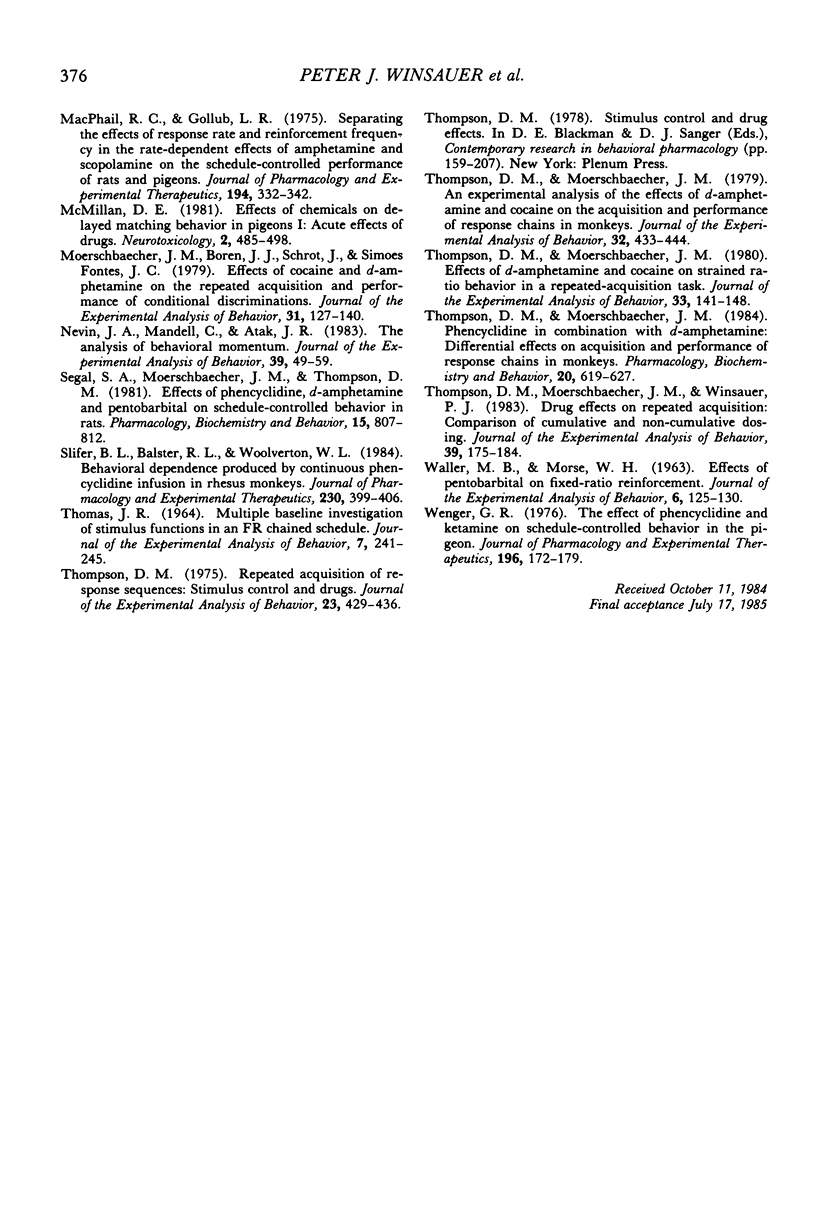
Selected References
These references are in PubMed. This may not be the complete list of references from this article.
- Blackman D. Response rate, reinforcement frequency, and conditioned suppression. J Exp Anal Behav. 1968 Sep;11(5):503–516. doi: 10.1901/jeab.1968.11-503. [DOI] [PMC free article] [PubMed] [Google Scholar]
- Branch M. N. Rate dependency, behavioral mechanisms, and behavioral pharmacology. J Exp Anal Behav. 1984 Nov;42(3):511–522. doi: 10.1901/jeab.1984.42-511. [DOI] [PMC free article] [PubMed] [Google Scholar]
- Brown H., Bass W. C. Effect of drugs on visually controlled avoidance behavior in rhesus monkeys: a psychophysical analysis. Psychopharmacologia. 1967;11(2):143–153. doi: 10.1007/BF00401251. [DOI] [PubMed] [Google Scholar]
- DEWS P. B. Studies on behavior. I. Differential sensitivity to pentobarbital of pecking performance in pigeons depending on the schedule of reward. J Pharmacol Exp Ther. 1955 Apr;113(4):393–401. [PubMed] [Google Scholar]
- FERSTER C. B., HAMMER C. VARIABLES DETERMINING THE EFFECTS OF DELAY IN REINFORCEMENT. J Exp Anal Behav. 1965 Jul;8:243–254. doi: 10.1901/jeab.1965.8-243. [DOI] [PMC free article] [PubMed] [Google Scholar]
- Ferster C. B., Peele D. B. The contribution of an added counter to a fixed-ratio schedule. J Exp Anal Behav. 1980 Jul;34(1):93–105. doi: 10.1901/jeab.1980.34-93. [DOI] [PMC free article] [PubMed] [Google Scholar]
- Harting J., Mcmillian D. E. Effects of pentobarbital and d-amphetamine on the repeated acquisition of response sequences by pigeons. Psychopharmacology (Berl) 1976 Sep 29;49(3):245–248. doi: 10.1007/BF00426823. [DOI] [PubMed] [Google Scholar]
- Jwaideh A. R. Responding under chained and tandem fixed-ratio schedules. J Exp Anal Behav. 1973 Mar;19(2):259–267. doi: 10.1901/jeab.1973.19-259. [DOI] [PMC free article] [PubMed] [Google Scholar]
- Katz J. L. Effects of drugs on stimulus control of behavior. I. Independent assessment of effects on response rates and stimulus control. J Pharmacol Exp Ther. 1982 Dec;223(3):617–623. [PubMed] [Google Scholar]
- Leander J. D. Comparison of phencyclidine, etoxadrol and dexoxadrol in the pigeon. Subst Alcohol Actions Misuse. 1982;3(4):197–203. [PubMed] [Google Scholar]
- MacPhail R. C., Gollub L. R. Separating the effects of response rate and reinforcement frequency in the rate-dependent effects of amphetamine and scopolamine on the schedule-controlled performance of rats and pigeons. J Pharmacol Exp Ther. 1975 Aug;194(2):332–342. [PubMed] [Google Scholar]
- McMillan D. E. Effects of chemicals on delayed matching behavior in pigeons I: acute effects of drugs. Neurotoxicology. 1981 Nov;2(3):485–498. [PubMed] [Google Scholar]
- Moerschbaecher J. M., Boren J. J., Schrot J., Fontes J. C. Effects of cocaine and d-amphetamine on the repeated acquisition and performance of conditional discriminations. J Exp Anal Behav. 1979 Jan;31(1):127–140. doi: 10.1901/jeab.1979.31-127. [DOI] [PMC free article] [PubMed] [Google Scholar]
- Nevin J. A., Mandell C., Atak J. R. The analysis of behavioral momentum. J Exp Anal Behav. 1983 Jan;39(1):49–59. doi: 10.1901/jeab.1983.39-49. [DOI] [PMC free article] [PubMed] [Google Scholar]
- Segal S. A., Moerschbaecher J. M., Thompson D. M. Effects of phencyclidine, d-amphetamine and pentobarbital on schedule-controlled behavior in rats. Pharmacol Biochem Behav. 1981 Nov;15(5):807–812. doi: 10.1016/0091-3057(81)90026-5. [DOI] [PubMed] [Google Scholar]
- Slifer B. L., Balster R. L., Woolverton W. L. Behavioral dependence produced by continuous phencyclidine infusion in rhesus monkeys. J Pharmacol Exp Ther. 1984 Aug;230(2):399–406. [PubMed] [Google Scholar]
- THOMAS J. R. MULTIPLE BASELINE INVESTIGATION OF STIMULUS FUNCTIONS IN AN FR CHAINED SCHEDULE. J Exp Anal Behav. 1964 May;7:241–245. doi: 10.1901/jeab.1964.7-241. [DOI] [PMC free article] [PubMed] [Google Scholar]
- Thompson D. M., Moerschbaecher J. M. An experimental analysis of the effects of d-amphetamine and cocaine on the acquisition and performance of response chains in monkeys. J Exp Anal Behav. 1979 Nov;32(3):433–444. doi: 10.1901/jeab.1979.32-433. [DOI] [PMC free article] [PubMed] [Google Scholar]
- Thompson D. M., Moerschbaecher J. M. Effects of d-amphetamine and cocaine on strained ratio behavior in a repeated-acquisition task. J Exp Anal Behav. 1980 Jan;33(1):141–148. doi: 10.1901/jeab.1980.33-141. [DOI] [PMC free article] [PubMed] [Google Scholar]
- Thompson D. M., Moerschbaecher J. M. Phencyclidine in combination with d-amphetamine: differential effects on acquisition and performance of response chains in monkeys. Pharmacol Biochem Behav. 1984 Apr;20(4):619–627. doi: 10.1016/0091-3057(84)90313-7. [DOI] [PubMed] [Google Scholar]
- Thompson D. M., Moerschbaecher J. M., Winsauer P. J. Drug effects on repeated acquisition: comparison of cumulative and non-cumulative dosing. J Exp Anal Behav. 1983 Jan;39(1):175–184. doi: 10.1901/jeab.1983.39-175. [DOI] [PMC free article] [PubMed] [Google Scholar]
- Thompson D. M. Repeated acquisition of response sequences: stimulus control and drugs. J Exp Anal Behav. 1975 May;23(3):429–436. doi: 10.1901/jeab.1975.23-429. [DOI] [PMC free article] [PubMed] [Google Scholar]
- WALLER M. B., MORSE W. H. Effects of pentobarbital on fixed-ratio reinforcement. J Exp Anal Behav. 1963 Jan;6:125–130. doi: 10.1901/jeab.1963.6-125. [DOI] [PMC free article] [PubMed] [Google Scholar]
- Wenger G. R. The effect of phencyclidine and ketamine on schedule-controlled behavior in the pigeon. J Pharmacol Exp Ther. 1976 Jan;196(1):172–179. [PubMed] [Google Scholar]


